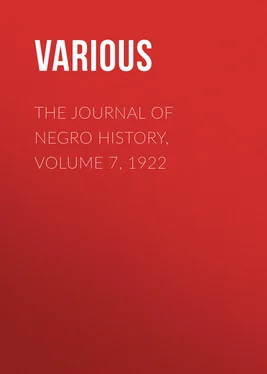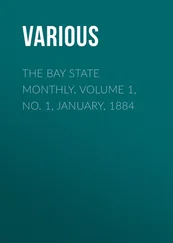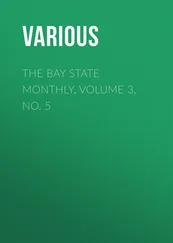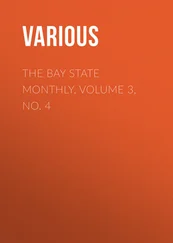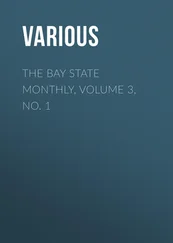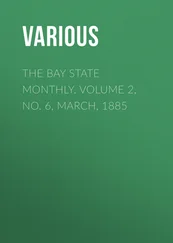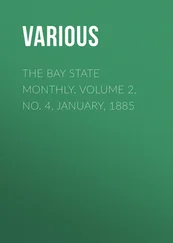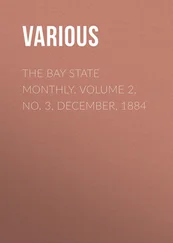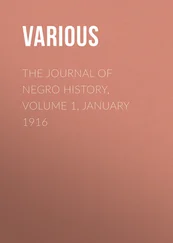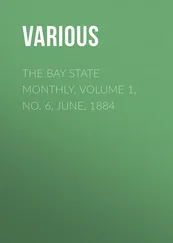Various - The Journal of Negro History, Volume 7, 1922
Здесь есть возможность читать онлайн «Various - The Journal of Negro History, Volume 7, 1922» — ознакомительный отрывок электронной книги совершенно бесплатно, а после прочтения отрывка купить полную версию. В некоторых случаях можно слушать аудио, скачать через торрент в формате fb2 и присутствует краткое содержание. Жанр: foreign_antique, periodic, История, foreign_edu, на английском языке. Описание произведения, (предисловие) а так же отзывы посетителей доступны на портале библиотеки ЛибКат.
- Название:The Journal of Negro History, Volume 7, 1922
- Автор:
- Жанр:
- Год:неизвестен
- ISBN:нет данных
- Рейтинг книги:3 / 5. Голосов: 1
-
Избранное:Добавить в избранное
- Отзывы:
-
Ваша оценка:
- 60
- 1
- 2
- 3
- 4
- 5
The Journal of Negro History, Volume 7, 1922: краткое содержание, описание и аннотация
Предлагаем к чтению аннотацию, описание, краткое содержание или предисловие (зависит от того, что написал сам автор книги «The Journal of Negro History, Volume 7, 1922»). Если вы не нашли необходимую информацию о книге — напишите в комментариях, мы постараемся отыскать её.
The Journal of Negro History, Volume 7, 1922 — читать онлайн ознакомительный отрывок
Ниже представлен текст книги, разбитый по страницам. Система сохранения места последней прочитанной страницы, позволяет с удобством читать онлайн бесплатно книгу «The Journal of Negro History, Volume 7, 1922», без необходимости каждый раз заново искать на чём Вы остановились. Поставьте закладку, и сможете в любой момент перейти на страницу, на которой закончили чтение.
Интервал:
Закладка:
The Baptists were at the same time receiving recruits from another source. In June, 1862, while a destructive war was being waged by the Southern States against the Union, warning was given that a terrible siege was to be started against the city of Fredericksburg, Virginia. This news caused between three and four hundred members of the Shiloh Baptist Church of that town to leave for Washington as a place of refuge. After arriving there many tearful eyes were turned toward the dear old church of their childhood and riper years, where "many a pleasant hour had been enjoyed, and it was only natural for these fellow church members to plan for a place where they might once more gather in prayer and praise God for their deliverance from the ravages of war." 87Home gatherings were frequent among these refugees and in this way the organization of the present church was effected.
Shiloh Baptist Church, like many other churches, had its beginning in a Sunday School. 88The constant meeting of these seekers after the truth served to keep a number of them in close touch with each other and intensified the desire for a church of their own. They then began to meet in each other's houses for prayer and for conference upon the subject and soon resolved to have a Shiloh Baptist Church in Washington, since they could not return to Shiloh Church in Fredericksburg. It was at one of these prayer meetings in the bedroom of Henry D. Peyton in an old brick house on K Street, between 26th and 27th Streets, in Georgetown (now West Washington) that Shiloh Baptist Church of Washington had its beginnings in September, 1863. 89
Having formed the church, the founders sent a communication to the various Baptist churches of Washington, both white and black, asking that a council be called to consider the propriety of recognizing them as a regularly constituted Baptist church. The Negro Baptist churches gave these petitioners no encouragement and sent no delegates to the council, but the white Baptist churches sent a number of their members, deacons, and pastors, as delegates, who met in the First white Baptist church, located at that time on 13th Street between G and H Streets, Northwest, at eight o'clock Wednesday evening, September 23, 1863, and formed a recognition council. Dr. G. W. Sampson, pastor of the First Baptist Church and President of Columbian College, was chosen Moderator, and John S. Poler, clerk. After approving the credentials of the delegates the Moderator stated the purpose of the meeting. He further stated that the council had also been asked to examine William J. Walker as to his fitness and qualification for the gospel ministry, and if found worthy to ordain him, as the church had called him as its pastor and recommended his ordination. 90It was so ordered and done by the council.
The church continued to meet in the homes of the members, but it grew so rapidly that it soon became necessary to secure larger quarters. The little frame building on the north side of L Street, between 16th and 17th Northwest, was then bought, and the church moved into it and remained there until 1868. The church prospered greatly and soon outgrew its first meeting house. Steps were then taken to purchase a site and erect a building sufficiently large to accommodate the growing membership. The present lot was secured, and in 1868 a commodious frame structure was erected thereon and used until 1883, when the church tore down the frame building and erected upon the same spot the present brick edifice.
William J. Walker, the first pastor, played a large part in building up the Baptist denomination in the District of Columbia and adjoining States. He organized four churches in Washington, namely, Zion Baptist, Enon Baptist, Mt. Zion Baptist and Mt. Jezreel Baptist churches, and two churches in Virginia, all of which are strong and prosperous organizations. He also founded the Baptist Sunday School Union and the Woman's Baptist Home Mission Society.
For a year or more after the death of William J. Walker the church remained without a pastor. During the greater part of this time William H. Scott served as supply, and it was while he was serving the church that the Walker Memorial Baptist Church was formed out of the members who drew out of Shiloh. Dr. J. Anderson Taylor became pastor in 1890 and remained with the church until near the close of 1906. During his ministry the church greatly increased in membership, and enlarged its building at a cost of $10,000. When Dr. Taylor gave up the pastorate of the church about 200 members withdrew from Shiloh and formed the Trinity Baptist Church and called him to take charge thereof. Shiloh Baptist Church, then, has been divided twice within twenty-three years. In spite of these handicaps, however, the church has prospered financially, numerically and spiritually. Dr. J. Milton Waldron took formal charge of Shiloh Baptist Church on the 6th of June 1907 and has labored with success in edifying his congregation and extending the influence of the church. 91
While the organization of Shiloh Church was being effected in the northern section of Washington, there was in the southwest also another group from Fredericksburg. This effort resulted in the establishment of the Zion Baptist Church. They first organized a Sunday and day school in Jackson's School House on Delaware Avenue and L Street, Southwest. Their next movement was the organization of a church, September 12, 1864, with nine members. They bought what was then known as Simpson's Feed Store on the present site of the church, and remodeled this building in 1867; William J. Walker was its founder and first pastor. In January, 1869, William Gibbons of Charlottesville, Virginia, became the pastor and under his temporal and spiritual oversight the church flourished. The first church edifice was dedicated in 1871 and for twenty-one years was used by the congregation. In 1891 the present structure was built at an expenditure of $35,000. The membership at the forty-eighth anniversary was 2,310, the largest at the time in the District of Columbia. Up to the close of the nineteenth century they raised annually on an average of $8,000 for current expenses. Their present pastor, William J. Howard, has a unique record as being one of the best known ministers and men in the city, regardless of denomination, and with a character beyond reproach. 92
The Metropolitan, formerly known as the Fourth Baptist Church, was organized May 1863 by a few holding letters from the Nineteenth Street Baptist Church during the pastorate of Duke W. Anderson, and by a few members from other churches. Henry Bailey was the first pastor of the new group. In 1865 there took place a division of this body which resulted in the establishment of the Fifth, now the Vermont Avenue Baptist Church. The organization was effected in a mission building which stood in the intersection of what is now E Street and Vermont Avenue. Two contending parties, both claiming to be the Fourth Baptist Church, were then engaged in presenting their rival claims. Four church councils were held before it was established which one had the right to bear the title Fourth. Robert Johnson took charge in 1870, seven years after the original movement. Under him the establishment prospered.
Four buildings have been used as church edifices in the history of this congregation, the mission building referred to above, the barracks, a relic of the Civil War, and a frame structure on the site of the present edifice, which at that time of its dedication in 1884 was valued at $60,000; but today the valuation, conservatively speaking, may be placed at $175,000. From 1865 to 1890 the membership was about 2,000, 1,100 of whom were baptized by Robert Johnson. The first Washington Baptist Convention composed of churches principally of the District of Columbia requested in September, 1890, that the church be called the Metropolitan. The congregation formally agreed to bear the title and since then Metropolitan has been its legal as well as its popular name.
Читать дальшеИнтервал:
Закладка:
Похожие книги на «The Journal of Negro History, Volume 7, 1922»
Представляем Вашему вниманию похожие книги на «The Journal of Negro History, Volume 7, 1922» списком для выбора. Мы отобрали схожую по названию и смыслу литературу в надежде предоставить читателям больше вариантов отыскать новые, интересные, ещё непрочитанные произведения.
Обсуждение, отзывы о книге «The Journal of Negro History, Volume 7, 1922» и просто собственные мнения читателей. Оставьте ваши комментарии, напишите, что Вы думаете о произведении, его смысле или главных героях. Укажите что конкретно понравилось, а что нет, и почему Вы так считаете.
